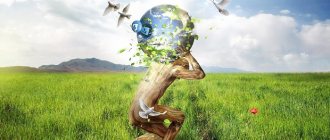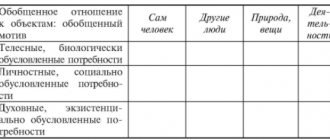Phenotype is a set of characteristics inherent in an individual at a certain stage of development. Any observable characteristic or trait of an organism: such as its morphology, development, biochemical and physiological properties, or behavior.
Phenotypes are shaped by the genotype, mediated by a number of environmental factors and possible interactions between the two.
All clinically detectable characteristics of an individual: height, body weight, eye color, hair shape, blood type, etc. - phenotypically.
The concept of phenotype has some uncertainties. First, most of the molecules and structures encoded by genetic material are not noticeable in the external appearance of the organism, although they are part of the phenotype. An example of this is the situation with human blood groups. Therefore, the expanded definition of phenotype should include characteristics that can be detected by technical, medical or diagnostic procedures. A further, more radical extension could include learned behavior or even the organism's influence on the environment and other organisms. For example, Richard Dawkins believes that the dam of beavers, like their incisors, can be considered a phenotype of beaver genes.
Phenotype can be defined as the adaptation of genetic information to environmental factors. We can talk about two characteristics of a phenotype: a) the number of directions of adaptation characterizes the number of environmental factors to which the phenotype is sensitive, called the dimension of the phenotype; b) the degree of adaptation characterizes the degree of sensitivity of the phenotype to this environmental factor. Together, these characteristics determine the richness and development of the phenotype. The more multilayered the phenotype and the more sensitive it is, the further the phenotype is from the genotype, the richer it is. If we compare a virus, a bacterium, an ascaris, a frog and a human, then the richness of the phenotype in this series increases.
The relationship between phenotype and genotype
The genotype of an organism determines its phenotype. All living organisms have DNA, which provides instructions for the production of molecules, cells, tissues and organs. DNA contains the genetic code, which is also responsible for directing all cellular functions, including mitosis, DNA replication, protein synthesis, and molecular transport.
An organism's phenotype (physical traits and behavior) is determined by its inherited genes. Genes are specific sections of DNA that encode the structure of proteins and determine various characteristics. Each gene is located on a chromosome and can exist in more than one form. These different forms are called alleles, which are located in specific locations on specific chromosomes. Alleles are passed from parents to offspring through sexual reproduction.
Diploid organisms inherit two alleles for each gene; one allele from each parent. The interactions between alleles determine the phenotype of an organism. If an organism inherits two identical alleles for a particular trait, it is homozygous for that trait. Homozygous individuals express one phenotype for a given trait. If an organism inherits two different alleles for a particular trait, it is heterozygous for that trait. Heterozygous individuals can express more than one phenotype for a given trait.
Complete, incomplete and co-dominance
Traits can be dominant or recessive. In complete dominance inheritance patterns, the phenotype of the dominant trait completely masks the phenotype of the recessive trait. There are also cases where the relationship between different alleles does not show complete dominance. In incomplete dominance, the dominant allele does not completely mask the other allele. This results in a phenotype that is a mixture of the phenotypes observed in both alleles. With codominance, both alleles are fully expressed. This results in a phenotype in which both traits are observed independently of each other.
| Type of dominance | Trait | Alleles | Genotype | Phenotype |
| Complete Domination | Color | R-red, r-white | Rr | Red color |
| Incomplete dominance | Color | R-red, r-white | Rr | pink color |
| Codominance | Color | R-red, r-white | Rr | red and white color |
How can environment interact with genotype during development?
It is clear that the result of development - the phenotype - depends on the joint action of genes and the environment. Genes and traits are linked through a complex network of developmental pathways. All individual differences that differential psychologists and psychogeneticists are concerned with are the result of the developmental circumstances of specific individuals in specific environments. Often individuals brought up in apparently different environments have much in common. Conversely, siblings raised in the same family, seemingly under similar circumstances, due to subtle differences in the conditions of upbringing and development, will actually experience very different influences from both the physical and social environment.
Thus, the process of interaction with the environment is complex and ambiguous. Note also that psychologists and other researchers often use the term “interaction” in a statistical sense when examining the interaction of individual factors in the production of any measurable effect. Let us emphasize that the statistical interaction of factors and the interaction of genes and environment in individual development are completely different things. They should not be confused.
For us, the formulation is quite familiar, which states that the manifestation of a phenotype is the result of the interaction of the genotype with the environment during development. However, if you think about this statement, it does not seem so obvious. After all, interaction presupposes that its participants come into contact and come into contact. In fact, our genotype, that is, the genetic apparatus, is hidden deep inside the cell and is separated from the external environment not only by the integument of the body, but also by the cellular and nuclear membranes. How can the external environment interact with genetic structures?
It is clear that genes and the surrounding world are not in direct contact. The organism as a whole interacts with the external environment; genes interact with various biochemical substances inside the cell. But various cellular substances can be influenced by the outside world. Let's consider what is known about these processes today's science. To do this, we will again have to turn to molecular genetics and consider in more detail how genes function, since in the previous presentation we only stated that the main function of a gene is to encode the information necessary for the synthesis of a specific protein.
see also
- Gender dispersion
Wikimedia Foundation. 2010.
Synonyms
:
See what “Phenotype” is in other dictionaries:
- Phenotype ... Spelling dictionary-reference book
phenotype
- (from the Greek phaino I detect, reveal and typos imprint, form, sample) any observable sign of an organism, morphological, physical, behavioral. The term was proposed in 1909 by the Danish biologist V. Johansen. F. is a product... ... Great psychological encyclopedia
— [Dictionary of foreign words of the Russian language
- (from fen and type), the totality of all the characteristics of an organism (usually its appearance), which are the result of the interaction of the genotype with the environment. The phenotype changes during the individual development of an individual. Ecological encyclopedic... ... Ecological dictionary
phenotype
- a, m. phenotype <gr. phaino I show, I show + typos example. biol. The totality of all the signs and properties of an organism formed in the process of its individual development (ontogenesis). BAS 1. Lex. Garnet: phenotype; SIS 1937: fenoti/p;… …Historical Dictionary of Gallicisms of the Russian Language
- (from the Greek phaino I show and type), the totality of all the signs and properties of an organism formed in the process of its individual development. It develops as a result of the interaction of the hereditary properties of the organism, genotype and environmental conditions... ...Modern encyclopedia
- (from the Greek fen and type) in biology, the totality of all the signs and properties of an organism formed in the process of its individual development. It develops as a result of the interaction of the hereditary properties of the organism, genotype and environmental conditions ... Big Encyclopedic Dictionary
- (from the Greek phaino I appear, appear and typos imprint, image) changes in genotypic characteristics caused by the course of individual life activity under certain environmental influences ... Psychological Dictionary
PHENOTYPE, the totality of all the characteristics and properties of an organism formed in the process of its individual development. It develops as a result of the interaction of HEREDITARY and environmental conditions. It also differs from GENOTYPE because... ... Scientific and Technical Encyclopedic Dictionary
- (from the Greek phaino I show, I discover and type), the totality of all the characteristics and properties of an individual that are formed in the process of interaction of its genetic. structure (genotype) and the environment external to it. The term "F." introduced by V. Iogansey in 1903. In F. ... ... Biological Encyclopedic Dictionary
The word “phenotype” is of Greek origin and is translated (literally) as “discover”, “reveal”. What is the practical significance of this concept?
What is GENOTYPE and PHENOTYPE - definition in simple words.
In simple words, Genotype is internally encoded heritable information that is carried by all living things. This is a kind of master plan or set of instructions for building a new organism, which indicates all the parameters of how this organism will look and function. These instructions are transmitted in encoded form - genetic code. In turn, the genetic code is present in all cells of the body, and it is copied during cell division or reproduction, passing on hereditary information to offspring. The information contained in the genetic code is directly related to all aspects of the life of the cell and the organism as a whole. It is she who controls absolutely all processes, from the formation of protein macromolecules to the regulation of metabolism and cell regeneration.
In simple words, Phenotype is the appearance and behavior of a particular individual. In other words, it is the result of what an organism has become under the influence of the components of the genotype, the ratio of dominant alleles and the environment.
GENOTYPE and PHENOTYPE - how they differ.
Speaking of such two concepts as “genotype” and “phenotype”, first of all it should be noted that they are indeed closely related to each other, but have fundamental differences. The fact is that the term Genotype is applicable specifically to the genetic information contained in the gene code. The genotype can only be determined through biological tests and studies. In turn, the phenotype is the consequences of the genotype and other factors that can simply be seen.
If we talk about the differences quite simply, then:
- The genotype is a code (it cannot just be seen);
- Phenotype is the way the code manifests itself (you can observe: eye color, hair color, height, behavior, etc.).
In conclusion, I would like to note that in fact, the topic of genotypes, phenotypes, their characteristics and influence is a very broad topic that occupies a significant layer in biology. In this article, we only introduced you to what the definitions of genotype and phenotype are in the most accessible and understandable way.
General information
Despite a fairly precise definition of what a phenotype is, its concept has a number of uncertainties. Most of the structures and molecules that are encoded by genetic material are not found in the external appearance of the organism. Moreover, they are part of the phenotype. An example is the blood phenotype of humans. In this regard, according to a number of authors, the definition should include those characteristics that can be obtained using diagnostic, medical or technical procedures. A more radical further expansion may include acquired behavior, and, if necessary, the influence of the organism on the environment and other organisms. So, for example, the incisors and dam of beavers can be taken as their phenotype.
What is genotype
This is the totality of hereditary information in the body. In other words, it is the sum of genes that forms a single system.
Unlike the gene pool, it describes not the entire species, but an individual.
How to determine genotype
To determine the genotype of animals and plants, analytical crossbreeding is used. It is based on crossing an indeterminate individual and an individual with a homozygous (identical) set of chromosomes.
Since the second individual produces one gamete of a recessive trait, identifying the first individual is easy and simple.
But a person, in order to find out his set of genes, needs to be tested in a special laboratory.
How the genotype changes
A change in the set of genes can be caused by a mutation. During this process, the structure of DNA changes, which can be inherited. Mutations occur for various reasons.
For example, due to ultraviolet rays, radiation or exposure to chemicals.
Mutations are divided into:
- genetic;
- chromosomal;
- genomic;
- somatic;
- cytoplasmic.
Gene mutations imply a change in the structure of one gene, chromosomal mutations mean a modification of the structure of a chromosome, genomic mutations mean changes in the number of chromosomes.
Mutations can also be spontaneous or artificial. The first occur spontaneously and occur throughout life. The latter are artificially caused in the laboratory.
Mutations are mostly lethal or neutral. Occasionally, mutations are beneficial to the body.
The set of genes can also change due to combinative variability. It is based on the recombination of genes during the sexual process.
As a result of what process is the genotype of the offspring formed?
It is formed as a result of the fusion of parent gametes. For example, when two homozygous organisms merge, the offspring will receive the genotype “aa”.
Accidents of development
The variability of developmental phenomena depends on many reasons. Heredity tends to reduce developmental variability, whereas conditions not associated with heredity tend to increase it. Some developmental researchers identify four types of random factors that influence developmental variability:
- accidents in the selection of parental pairs, the genes of which make up the genotype of the individual;
- randomness of epigenetic (that is, external to the genotype) processes within individual ontogenesis;
- the randomness of the maternal environment in which the individual develops;
- the randomness of the non-maternal environment in which the individual develops.
Although these are random events, they all have an element of heredity. The genotype is inherited from the parents, and the offspring and parents have common genes that influence the course of individual development. Epigenetic processes within the body represent the influence of other cells or their products on the activity of the genotype of a given cell. Since all cells in the body have the same genotype, it is natural that epigenetic influences are associated with heredity. However, epigenetic processes are stochastic, open to the influence of environmental factors of the organism and, therefore, to any historical accidents.
The maternal environment of mammals is a very important element of the external environment. Mothers provide the intrauterine and postnatal (baby care and education) environment for the child. It is clear that these conditions are influenced by the mother's genotype. Partially, the mother's genes are shared with the offspring, so the maternal environment can be inherited. The maternal environment is also sensitive to historical contingencies.
Nonmaternal environmental effects also influence developmental variability. This includes factors that are chosen by the individual himself or shaped by the people around him, including relatives with whom he shares genes. Therefore, these environmental effects, to some extent, are also influenced not only by random environmental events, but also by genes, and are also inherited (genotype-environmental covariation).
Thus, in accordance with the above classification, in all the described elements of the environment external to a given individual, there are mechanisms for inheritance, both genetic and non-genetic (various traditions, etc.).
Naturally, non-heritable factors also influence development. These are those features of the environment that are not associated with changes caused by the developing individual himself or his related environment. They can be either random or natural. Regular changes include cyclical changes (change of day and night, change of seasons, etc.), widespread influences (gravity) or predictable factors (temperature, pressure). Non-heritable factors are also present in the maternal and other social environment (quality of maternal nutrition, maternal stress level, number and gender of siblings, etc.). Randomly or systematically changing environmental events contribute to variability in development.
All events external to genes that take place during the process of ontogenesis, together with genetic factors, create the background against which development takes place. Due to the impact of a huge variety of regular and random events in ontogenesis, developing systems can organize and reorganize. Genes make development possible, but other components that influence the development of the system are no less important participants in the development process.
At the beginning of the presentation, defining the concept of phenotype, we emphasized that the phenotype is the result of the interaction of the genotype and the environment, however, in the light of what has been said about the process of individual development, we must make some clarification in this formulation and, along with environmental factors, mention accidents of development that cannot be reduced to purely environmental influences. If we tried to graphically depict the dependence of the phenotype on various factors, then we would need at least a four-dimensional space in which, in addition to the axes for genotype and environment, there would also have to be an axis for the accidents of development.
Links[edit]
- "phenotype adjective - definition, pictures, pronunciation and usage notes". Oxford Advanced Learner's Dictionary at OxfordLearnersDictionaries.com
. Retrieved April 29, 2021. a set of observable characteristics of an individual resulting from the interaction of his genotype with the environment. - "Genotype vs. Phenotype". Understanding Evolution
. Retrieved April 29, 2021. An organism's genotype is the set of genes it carries. An organism's phenotype is all of its observable characteristics that are influenced by both its genotype and its environment. - ^ ab Dawkins, Richard (12 January 1978). "Replicator selection and extended phenotype". Ethology
.
47
(January 1–December 1978): 61–76. DOI: 10.1111/j.1439-0310.1978.tb01823.x. PMID 696023. - Churchill, F. B. (1974). "William Johannsen and the concept of genotype". Journal of the History of Biology
.
7
(1): 5–30. DOI: 10.1007/BF00179291. PMID 11610096. S2CID 38649212. - Johannsen, W. (1911). "The genotypic concept of heredity". American naturalist
.
45
(531): 129–159. DOI: 10.1086/279202. JSTOR 2455747. PMC 4258772. - Crusio, Wim E. (May 2002). "My mouse has no phenotype". Genes, Brain and Behavior
.
1
(2): 71. DOI: 10.1034/j.1601-183X.2002.10201.x. PMID 12884976. S2CID 35382304. - Cassidy, Suzanne B.; Morris, Colleen A. (01/01/2002). "Behavioral phenotypes in genetic syndromes: genetic clues to human behavior". Advances in Pediatrics
.
49
: 59–86. PMID 12214780. - O'Brien, Gregory; Yule, William, ed. (1995). Behavioral phenotype
. Developmental Medicine Clinic No. 138. London: Mac Keith Press. ISBN 978-1-898683-06-3. - O'Brien, Gregory, ed. (2002). Behavioral phenotypes in clinical practice. London: Mac Keith Press. ISBN 978-1-898683-27-8. Retrieved September 27, 2010.
- Lewontin, RC (November 1970). "Units of Selection" (PDF). Annual Review of Ecology and Systematics
.
1
: 1–18. DOI: 10.1146/annurev.es.01.110170.000245. JSTOR 2096764. - “Botany Online: Evolution: Modern Synthesis - Phenotypic and Genetic Variations; ecotypes". Archived from the original on 2009-06-18. Retrieved December 29, 2009.
- Dawkins, Richard (1982). Extended phenotype. Oxford University. clause 4. ISBN 978-0-19-288051-2.
- Hunter, Philip (2009). “Extended reduction phenotype. How far can genes extend when manipulating an organism's environment?" . EMBO Reports
.
10
(3): 212–215. DOI: 10.1038/embor.2009.18. PMC 2658563. PMID 19255576. - Mahner, M. & Karogo, M. (1997). “What are genomes, genotypes and phenotypes? What about phenomena?" Journal of Theoretical Biology
.
186
(1):55–63. DOI: 10.1006/jtbi.1996.0335. PMID 9176637. - Varkey, A; Wills, C; Perlmutter, D; Woodruff, D; Gage, F; Moore, J; Semendeferi, K; Bernirschke, K; Katzman, R; and others. (1998). "Great Ape Phenome Project?" The science
.
282
(5387): 239–240. Bibcode: 1998Sci…282..239V. DOI: 10.1126/science.282.5387.239d. PMID 9841385. S2CID 5837659. - Houle, David; Govindaraju, Diddahally R.; Ömholt, Stig (December 2010). "Phenomics: the next challenge." Nature Genetics Reviews
.
11
(12): 855–866. DOI: 10.1038/nrg2897. PMID 21085204. S2CID 14752610. - Framer, Nelson; Sabatti, Chiara (May 2003). "The Human Phenomenon Project." Genetics of Nature
.
34
(1): 15–21. DOI: 10.1038/ng0503-15. PMID 12721547. S2CID 31510391. - Rahman, Hifzur; Ramanathan, Valarmati; Jagadeeshselvam, N.; Ramasamy, Shashikala; Rajendran, Satishraj; Ramachandran, Mahendran; Sudhir, Pamidimarri DVN; Chauhan, Sushma; Natesan, Senthil (01/01/2015). Barkh, Debmalya; Khan, Muhammad Sarwar; Davis, Eric (ed.). PlantOmics: Omics of Plant Science
. Springer India. pp. 385–411. DOI: 10.1007/978-81-322-2172-2_13. ISBN 9788132221715. - Fairbank, Robert T.; Tester, Mark (12/01/2011). “Phenomics—technologies for eliminating phenotyping bottlenecks.” Trends in crop production
.
16
(12): 635–644. DOI: 10.1016/j.tplants.2011.09.005. PMID 22074787. - Monte, Andrew A.; Broker, Chad; Nebert, Daniel W.; Gonzalez, Frank J.; Thompson, David S.; Vasiliou, Vasilis (12/01/2014). "Improved drug therapies: triangulating phenomena with genomics and metabolomics". Human Genomics
.
8
(1):16. DOI:10.1186/s40246-014-0016-9. PMC 4445687. PMID 25181945.
Genotype, genome and gene pool
The term “genome” was proposed by the German biologist G. Winkler 10 years later than the concept of “genotype” was formulated.
Genome also refers to a collection of genes, but unlike a genotype, a gene is considered as a nucleotide sequence of DNA in haploid cells (with a single set of chromosomes), and not as an allele (an alternative form of the same gene) in a diploid set of chromosomes.
In order not to get lost in the jungle of genetics, it is important to understand the main thing:
The genome, being the hereditary material of an organism, is stored in several (sometimes in one) chromosomes, the number of which is unique for a particular species.
The genome size (based on the number of genes it contains) varies widely, reaching several tens of thousands of units. The fewest genomes were found in the simplest viruses (several hundred), the largest number were found in representatives of the plant world (for example, there are more than 46,000 of them in rice).
According to recent studies, the human genome consists of 46 chromosomes (23 pairs), which contain about 22-25 thousand genes.
Individuals from different populations can interbreed and produce offspring. The gene pool of a species is made up of the gene pool of populations.
The characteristic features of the gene pool include the following distinctive qualities:
- Under constant environmental conditions, the gene pool remains unchanged.
- When external conditions change, individuals whose genes possess traits useful for survival gain an advantage. It is these individuals that will pass on the most valuable qualities to their offspring during sexual reproduction.
- The genes responsible for the most “advantageous” traits accumulate from generation to generation, creating the basis for changes in the gene pool.
- The variability of the gene pool as a mechanism of natural selection is directional and helps to improve the adaptive functions of the body.
The evolutionary changes occurring in the population can be traced in the following examples. In harsh climatic conditions (extreme cold, heat), the proportion of genotypes that increase the thermal insulation of organisms increases.
In other cases, the preservation of a population largely depends on genes encoding the color of the animal (in order to improve camouflage), or the synthesis of protective enzymes (liquids, gases), or behavior patterns, etc.
All this makes the population (or species as a whole) more resistant to the external environment, and therefore ensures its survival.
It happens that some genes (in parents or their descendants) turn out to be damaged (mutated), but this has practically no effect on the genotype, since mutations caused by such genes are unstable and are almost never repeated in inheritance. It follows that the human genome is absolutely stable.
Why is the typical genotype record arbitrary?
Any gene discovered by scientists has a specific name. Most often these are English terms or phrases that can reach considerable lengths. The spelling of names is difficult for representatives of foreign science, so scientists have introduced a simpler recording of genes.
Even a high school student can sometimes know what genotype 3a is. This notation means that a gene is responsible for 3 alleles of the same gene. If the real gene name were used, understanding the principles of heredity might be difficult.
If we are talking about laboratories where serious karyotype research and DNA studies are carried out, then they resort to the official names of genes. This is especially true for those scientists who publish the results of their research.
The history of these concepts
What genotype and phenotype are can be understood by learning the history of the origin of these scientific terms. At the beginning of the twentieth century, the science of the structure of a living organism and biology was actively studied. We remember Charles Darwin's theory of evolution and the emergence of man. He was the first to put forward the Temporary hypothesis about the separation of cells in the body (gemmules), from which another individual could subsequently emerge, since these are germ cells. Thus, Darwin developed the theory of pangenesis.
41 years later, in 1909, the botanist Wilhelm Johansen, based on the concept of “genetics” already known in those years (introduced in 1906), introduced a new concept into the terminology of science - “gene”. The scientist replaced with it many words that were used by his colleagues, but which did not reflect the entire essence of the innate properties of a living organism. These are words such as “determinant”, “germ”, “hereditary factor”. During the same period, Johansen introduced the concept of “phenotype,” emphasizing the hereditary factor in the previous scientific term.
The influence of external conditions on the development of individual characteristics
It should be noted that the genotype is not a clear factor determining the phenotype. To one degree or another, the formation of a set of individual characteristics will also depend on the environment, that is, on external factors. In different conditions, phenotypes have sharp differences. For example, the species of butterflies “Arashnia” produces two offspring per year. Those individuals that emerged from overwintered pupae (spring ones) differ sharply from those that emerged in the summer. The phenotype of the plant may also differ. For example, in open space pine trees are spreading, but in the forest they are slender and tall. In the water buttercup, the shape of the leaf depends on where it is located - in the air or in the water.
Genotype and phenotype
- The genotype contains encoded hereditary information, represented by the genetic code, which can only be deciphered using biological tests.
- The phenotype is formed in the process of interaction of an individual’s genotype with the external environment and is a way of manifestation of the genetic code. It can be observed visually by such features as hair color (fur), eye color and shape, nose shape, demeanor, etc.
The phenotype has not only external, but also internal characteristics, which include:
- anatomical (structure and relative position of internal organs);
- physiological (cell structure and functioning);
- biochemical (protein structure, composition of hormones and enzymes).
This means that, under certain conditions, different genotypes are capable of creating phenotypes similar to each other, as well as vice versa: the same genotypes can produce a variety of phenotypes.
However, these changes occur within a certain limit, called the “reaction norm”: after all, nothing can appear in the phenotype beyond what is already “recorded” in the genotype.
The reaction rate can be illustrated with this example. The weight of an adult cow of a certain breed, due to genetic characteristics, cannot be more or less than a specific value, regardless of the conditions in which it is kept.
The same goes for milk yield: even with the best care, it will not exceed the maximum level for a given breed. And in response to poor maintenance, the cow may not give milk at all - and this will be logical and fair.
The relationship between genotype and phenotype is clearly visible in identical twins: having an absolutely identical set of genes (genotype), they are practically indistinguishable in the first days of life.
But as we grow older, phenotypic differences begin to appear: facial expression, hair color, behavior, etc.
Variability
Each individual is characterized by an individual genotype and phenotype. Genes do not always determine the external and internal structure of the body. For example, genes determine a tendency to obesity, but under the influence of the environment (healthy diet, exercise), obesity is not a feature of the phenotype. Another example: in the course of life, a person broke and changed the shape of his nose. By genotype a person has a straight nose, by phenotype - with a hump.
Variation in phenotype during life is called modification or phenotypic. It is acquired during life, but is not inherited.
There are two types of genetic variation:
- combinative
- the formation of new sets of genes during the process of meiosis; - mutational
- abrupt changes in genes that are inherited.
Rice. 3. Genetic variability.
Mutations, like phenotypic changes, accumulate throughout life, but are not always reflected in the phenotype. However, they can influence the genotype of subsequent generations.
Genotype and phenotype
Genotype and phenotype Genotype is a set of hereditary characteristics and properties received by an individual from its parents. As well as new properties that appeared as a result of gene mutations that the parents did not have. The genotype is formed through the interaction of two genomes (egg and sperm) and represents a hereditary development program, being an integral system, and not a simple sum of individual genes. The integrity of the genotype is the result of evolutionary development, during which all genes were in close interaction with each other and contributed to the preservation of the species, acting in favor of stabilizing selection. Thus, a person’s genotype determines (determines) the birth of a child, a hare’s offspring will be represented by hares, and only sunflower will grow from sunflower seeds. The genotype is not just the sum of genes. The possibility and form of gene manifestation depend on environmental conditions. The concept of environment includes not only the conditions surrounding the cell, but also the presence of other genes. Genes interact with each other and, once in the same genotype, can greatly influence the manifestation of the action of neighboring genes. A phenotype is the totality of all the characteristics and properties of an organism that have developed during the individual development of the genotype. This includes not only external signs (skin color, hair, ear or nose shape, flower color), but also internal ones: anatomical (body structure and relative arrangement of organs), physiological (shape and size of cells, structure of tissues and organs), biochemical ( protein structure, enzyme activity, concentration of hormones in the blood). Each individual has its own characteristics of appearance, internal structure, nature of metabolism, functioning of organs, i.e. its own phenotype, which was formed under certain environmental conditions. If we consider the results of self-pollination of F2 hybrids, we can find that plants grown from yellow seeds, being externally similar and having the same phenotype, have a different combination of genes, i.e. different genotype. The concepts of genotype and phenotype are very important in genetics. The phenotype is formed under the influence of the genotype and environmental conditions. It is known that the genotype is reflected in the phenotype, and the phenotype is most fully manifested in certain environmental conditions. Thus, the manifestation of the gene pool of a breed (variety) depends on the environment, i.e. conditions of detention (climatic factors, care). Often varieties developed in some areas are not suitable for cultivation in others.
Phenotypes of the Caucasian race of Europe
Phenotype is a set of characteristics inherent in an individual at a certain stage of development. A person’s phenotype is formed on the basis of his genotype, and can change throughout his life.
The computer processed thousands of photographs and “drew” average portraits of people who live in a certain territory of Europe. Then, using a special algorithm, scientists compiled phenotypes of people, representatives of the Caucasian (white) race , indicating the highest concentration of this anthropological type in the territories of modern countries and regions.
To begin with, let’s present summary collages with the faces of a hypothetical average woman of each European phenotype, and below will be a detailed description with “photo identikit” of men and women as typical representatives of this group of Caucasians.
Candidate of Biological Sciences Stanislav Drobyshevsky believes that the “Caucasian race” is most often called this, although in Russian anthropology the term “Eurasian race” is accepted. One could call it the “ Eurasian-African race ,” but there is no such term . The Caucasoid race is not only settled in Europe, its range is much wider, even without taking into account the fact that at present Caucasoids have settled anywhere: in Australia, in America, in Africa.
A 2008 study by geneticists found that the genetic mutation leading to blue eyes began approximately 10,000 years ago. The earliest examples of blue eyes are believed to have originated in the areas around the Black Sea. A genetic study of Europeans conducted in 2014 showed that today all blue-eyed people are related to ancestors who came from the family group whose mutation was first discovered in the Black Sea region. The results of a genetic study in 2014 mean that people with the gene for blue eyes appeared near the Black Sea and migrated to western Europe at a time when agriculture took precedence over hunting and gathering, farming came to Europe from east to west.
Phenotype of people of the Caucasian (white) race.
NORDID
Synonyms: Scandornordid, Halschdadt Nordid, Teuton-Nordid, Gotha.
Synonyms: Skandonordid, Hallstatt Nordid, Teutonordid, Gota
The face is oval, slightly diamond-shaped, with a narrow, somewhat sloping forehead with weak skin pigmentation, pinkish-white in color, the skin is thin, the texture is clearly visible. The bones are small compared to Cromanid. The hair is almost exclusively blond, although there are darker types morphologically similar to Atlanteans. Represents the end point of distribution and is rare in its pure form, but often found in mixtures with various of the types. Height: tall. Body type: ectomorphic.
Highest concentration
: in Sweden and Northern Europe.
Related types:
Nordocromanid, Celtic Nordid, Sub-Nordid, Eastern Nordid, Northern Atlantis, Norid.
NORDOCROMANID. (Nordocromagnid)
Synonyms: Trender, Anglo Sachs, Orkdel, Hardanger, Friterpian, Reihengraber
Synonyms: Tronder, Anglo Saxon, Orkdal, Hardanger, Friterpian, Reihengraber
Supposedly a mixture between Nordid and Dalofalid. More common than the two pure types. With a high head, the nose is typically straight or convex, and the jaw arches are less prominent than those of the Nordid. It has several subtypes, such as Trønder in Norway, Anglo-Saxon in Great Britain, Friterpian in the Netherlands and Reihengräber in Germany. Height: tall. Body type: ectomorphic, approaching mesomorphic.
Highest concentration:
Germany and Northern Europe.
Related types:
Nordid, East Nordid, Brunn, Borreby, Subnordid, Dalofalid.
CELTIC NORDIC. (Keltic Nordic). Synonym: Celt. Synonyms: Keltic
Named for its supposed association with early Celtic peoples. Derived from the pre-Roman invaders of Britain (Iron Age). Characterized by a mixture of Nordic, Dinaric, and a small number of other non-Nordic types. Red-haired representatives of the type are often found. Height: Tall. Body type: from ectomorphic to mesomorphic.
Highest concentration:
British Isles. Also a major element in Flanders, Southwestern Germany and the Alps.
Related types:
Brunn, Nordid, North Atlantis, Norid, Baskid.
SUBNORDID. (Subnordid). Synonym: Galat. Synonyms: Galatian
Nordid with Alpine admixture, highest concentration in Central Europe. Unlike Nordid and Alpinid, it is less established and more changeable. Occupies an intermediate morphological position between Nordid and Alpinid. Medium to tall height. Body type ranges from ectomorphic to endomorphic.
Highest concentration:
in West Germany, Switzerland and Austria. In several regions of Central Europe.
Related types:
Nordocromanid, Nordid, Atlantis, Alpinid.
EASTERN NORDID. (East Nordic)
Synonym: Cordid Nordid, Fenno Nordid. Synonyms: Corded Nordid, Fenno Nordid
It is similar to Nordida and there is a slight phenotypic difference between them, the main differences are in the structure of the forehead vault and nasal skeleton, the hair on the body is less developed. Distributed among Russians and Balts, less often among Finns. Height: Tall. Body type: from ectomophic to mesomorphic.
Highest concentration:
Western Russia, Eastern Europe, Russian Far East, Finland.
Related types:
Nordid, Eastern Baltide, Nordocromanid, Eastern Europid, Norid, Northern Pontide.
EASTERN EUROPEED (
East Europid)
A collective term for several similar types of Eastern European populations. They were originally grouped together with the Baltids, but differ from them: a thinner and longer nose and generally more Slavic features. A type with different hair colors and pigmentation, although lighter variations prevail. Height: average, body type: from mesomorphic to endomorphic.
Highest concentration:
Western Russia, Ukraine, Belarus.
Related types:
Baltid, Eastern Baltid, Western Baltid, Eastern Nordid, Gorid, Caucasid.
NORTH PONTID (
North Pondid)
Smooth facial features, high skull, narrow forehead, several narrow eye holes. Northern Pontides Recall the Atlantis of Western Europe, although they are not closely related. Height: from average to tall, body type from exomorphic to mesomorphic.
Highest concentration:
South of Russia, Ukraine, North Caucasus.
Related types:
Northern Atlantis, Eastern Nordid, Pontide, Iranian Nordid.
PONTID. (
Pontid)
Mediterranid subphylum with highest concentration in Southeastern Europe. Transitional to Northern Pontid and Baltoid (Gorid) phenotypes in the north and Dinaro Mediterranid and Eastern Mediterranid in the south. The type is rather thin, with smooth facial features, and is characterized by a high skull, narrow forehead, somewhat narrow eye sockets, less pigmented than the average Mediterranid. Medium to tall height, ectomorphic build.
Highest concentration:
Bulgaria, Ukraine, Greece, Türkiye.
Related types:
Gorid, Northern Pontide, Atlantomedoterranid, Gracile Medoterranid, Dinarid, Eastern Medoterranid.
ATLANTIS
Synonyms: Northern metaterranoid. ( Synonyms: North metaterranoyd)
Morphologically similar to Nordid, but has darker pigmentation. Distributed along the west coast of France, among the French. Height: average, ectomorphic build.
Highest concentration:
France, West Germany.
Related types:
Paleo-Atlantis, Northern Atlantis, Atlanto-Medoterranid, Subnordid.
BERID .
The medoterranid-cromanid has undergone alpinization but still contains many cromagnid elements belonging to the Cromanid phyla Paleo-Atlandids and Berberids. Height: from short to average, body type from endomorphic to mesomorphic.
The greatest concentration: in the mountainous regions of the Southern Iberian Peninsula, Southern Italy (Sardinia) and in Northern Africa, in Northern Fennoscandia, especially in Lapland.
Related types:
Paleo-Atlantean, Alpenid, Gracile Medoterranid,
BERBERID ( Berbirid)
Cromagnid of North African type, related to Berids and other cromanids of Europe. Pigmentation ranges from black hair and dark eyes to blond hair and blue eyes. Berberid is the least pigmented phenotype native to the African continent. They have a tall and narrow face, angular features, a straight nose, and a wide, low head. Berberid is particularly common in Berber populations, although Berbers can often have other North African phenotypes. Height: from tall to average, body type from endomorphic to mesomorphic.
Highest concentration:
mountainous regions of the Atlas, especially in Morocco and Algeria.
Related types:
Paleoatlantide, Berid, Egyptid, Sacharide, Southern Sacharide.
PALEO-ATLANTIS ( Paleo Atlantis)
Cromagnid with dark pigmentation. Robust, short-legged and long-armed, and dolichocephalic. Height: tall, mesomorphic build.
Highest concentration:
in Norway, Wales, Scotland and Ireland.
Related types:
Brun, Stardid, Atlantis, Dalofaelid, Berid, Berberid.
ATLANTO-MEDOTERRANID ( Atlanto-Mediterranid)
Strongly dolichocephalic Mediterranid, with a straight nose. Intermediate type between Atlantid and gracile Mediterranid. Height: medium to tall, ectomorphic build.
Highest concentration:
Northern Europe.
Related types:
Atlantis, Pontidas, Bascid, Dinarometotteranid, Slender Medottteranid.
DINARO-MEDOTERRANID. ( Dinaro Mediterranid)
A mixture between Dinarid and Mediterranid. It incorporates several Dinarid mixtures with various types of Western and European Mediterranid. Height: average, ectomorphic build.
Highest concentration:
Italy, Albania, Greece.
Related types:
Bascid, Dinarid, Atlantomethotheranid, Anadolid, Gracile Medoterranid, Eastern Medoterranid.
NORTH ATLANTID
Synonym: Northwestern. ( Synonyms: Northwestern)
Northern Atlantis is a mixture with Nordid or Celtic Nordic. North Atlanteans are generally dark-haired and light-eyed, and are an important element in the British Isles, and particularly in Wales. Less common in Scandinavia, West Germany and France. Height: medium to tall. Body type: ectomorphic.
Highest concentration: North-West Europe, Britain.
Related types: Celtic Nordic, Nordid, Atlantis, Northern Pontide.
GRACIAL MEDOTERRANID
Synonyms: medoterranid, small medoterranid, western medoterranid
Gracile. Synonyms: medoterranid, small medoterranid, western medoterranid
Straight nose and strong dolichocephalic Mediterranid type. Intermediate type between Atlantid and Mediterranid. Height: medium to tall, body type: ectomorphic.
Highest concentration:
in the northern part of the Iberian Peninsula, in Italy, and north along the western coast of Europe.
Related types:
Atlantomedoterranoid, Danaromedoterranoid, Sacharide, Pontid, Eastern Medoterranoid, Berid.
EASTERN MEDOTERRANID (
East Medoterranid)
Refers to the dolichocephalic Mediterranids, which are indigenous to the Eastern Mediterranean, from southern Italy and Greece to southern Turkey and Jordan. Height: average, ectomorphic build.
Highest concentration:
Eastern Mediterranean.
Related
types: Dinaromedoteranide, Gracilile Medoterranid, Saccharide, Pontid, Anatolide, Iranid.
SACHARIDE (Saccharides)
Synonyms: Southern Medoterranoid. ( Synonyms: South Medoterranoyd)
The thin and tall Mediterranid is found in North Africa, loosely influenced by more southern African types. Has some influence in Southern Europe, although not significantly. Medium to tall height, ectomorphic build.
Highest concentration:
Egypt, North Africa.
Related types:
Gracile Medoterranid, Eastern Medoterranid, Berberid, Arabid, Southern Sacharid, Egyptid.
BASKID (
Baskid)
The skull is particularly wide, with a "triangular" face. The nose is large and long, the chin is sharp. Pigmentation of hair color from black through dark red to blond hair. Height: medium to tall, mesomorphic build.
Highest concentration:
in Southwestern France and Northern Spain, one of the rarest European phenotypes.
Related types:
Paleoatlantid, Celtic Nordid, Atlantometorranid, Dinaromedoterranid.
NORID
Synonym: Norik, Subadriatic. ( Synonyms: Noric, Sub-Adriatic)
A mixture of Central European Nordide and Dinaride, a fairly stable type. The name comes from the Roman province of Noricum in today's Austria. A number of traits traditionally associated with the Dinarid phenotype are expressed. Medium to tall height. Body type: ectomorphic.
Highest concentration:
Austria, Slovenia and the Czech Republic. It is an important element in many regions of Central Europe.
Related types:
Nordid, Eastern Nordid, Celtic Nordic, Carpatid, Dinarid.
IRANIAN NORDOYD (
Iranian Nordoids)
Dolicho-mesocephalic, with an elongated face, depigmented type common in Western Asia. Pigmentation approaches Northern European standards. Hair ranges from blond to light brown, eyes are usually blue or green. Iranian Nordoids are probably a relic of the ancient Nordoid-Iranid/Indid. Found among the Kurds (Hakkari, Fayli), Western Iran and some of the surrounding areas. He is tall and has an ectomorphic build.
Highest concentration:
Small, isolated populations of this species have lived in eastern Turkey and Iran for thousands of years. Tium is relatively rare and difficult to find anywhere in any significant concentration.
Related types:
Northern Pontid, Robust-Iranid, Iradid, Eastern Iranid, Western Iranid, Nuristani-Kalash.
DINARID (
Dinarid)
Central and southeastern Caucasian, named with reference to the Dinaric Alps. Dinarids are typically brachycephalic with a long face and a long and often bulbous nose with intermediate to dark pigmentation. Height: tall, body type from ectomorphic to mesomorphic.
Highest concentration:
Balkans.
Related types:
Nordids, Carpatids, Dinarometotteranides, Caucasids, Pontides.
CARPATID (
Karpatid)
A hybrid type of the Carpathian Mountains, much like Gorid, except for the large nose. Probably formed by mixing Dinarid with a few Armenoid elements possibly. Brachycephalic, narrow-faced, thin nose, dark hair, dark eyes. Height: average, body type: from endomorphic to ectomorphic.
Highest concentration:
Northwestern Romania, Slovakia and along the Carpathians.
Related types:
Nordid, Caucasian, Gorid, Dinarid.
CAUCASID (
Kavkazid)
The indigenous type in the North Caucasus and neighboring regions, perhaps originally an intermediate type between the Dinarides and the Alpenids, is sometimes combined with Pontids and Baltids. Caucasids are characteristic of the Georgian population, and the type is also common among Chechens, Ingush and Ossetians. Height: tall, body build from endomorphic to mesomorphic.
Highest concentration:
The main population is in the North Caucasus region in southern Russia and Georgia. Regional type.
Related types:
Eastern Europides, Carpatids, Caspian, Dinarides, Armenides.
BALTID
Synonym: Tavastid. ( Synonyms: Tavastid)
They often have dark ash or blond hair and blue-gray eyes. Soft facial features and a snub nose are common to this type. Brachycephalic. Height: average. Body type ranges from mesomorphic to endomorphic.
Highest concentration:
Baltic, North-West Russia, Kaliningrad.
Related types:
Borrebi, Eastern Baltide, Western Baltide, Eastern Europid, Gorid.
WEST BALTID
Synonym: Eastern Kromanid, Kurganoid. ( Synonyms: East Cromagnid, Kurganoid)
Usually brachycephalic skull. Has the characteristics of Dalofalida and Baltida. They have characteristics of the Cromanids, the original population of Eastern Europe. Height: average. Body type: from mesomorphic to endomorphic.
Highest concentration:
in Poland, the Baltic countries and Belarus. Rarely represent the majority of the population.
Related types:
Baltides, Eastern Nordids, Borrebi, Eastern Europides, Dalophaelides.
EASTERN BALTID (East Baltid)
Synonym: Sauloxide. ( Synonyms: Savolaxid)
Formed as a result of the influx and subsequent stabilization of lappoid elements in the Baltic population. Similar to Lappid, but less pigmented. Some Mongoloid features can be found in the eyes. Brachycephalic and lightly pigmented with ash-blond hair and blue-gray eyes. Associated with the Northern Finns, Sami and peoples of the North of Russia. Height is low to average. Body build from endomorphic to mesomorphic.
Highest concentration:
The main population is in North-West Russia, Northern Finland/Sweden and Lapland. Often mixed with Nordids, Lappids, Baltids.
Related types:
Lappid, Uralid, Baltide, Eastern Europid.
BRUNN
Synonym: Cromanid. ( Synonyms: Cromagnid (Irish)
A small part of unreduced Cromandys, characteristic of the indigenous population of North-West Europe, especially in Ireland. The skin is generally fair, hair color can range from dark brown to blond, and red hair is common. Height: tall. Body type: mesomorphic.
Highest concentration:
Ireland, North-Western Europe.
Related types:
Nordocromanid, Borreby, Celtic Nordic, Dalofalid, Paleoatlantide.
BORREBY
Synonyms: Northern Alpinide, Fermarner. ( Synonyms: North Alpinoid, Fehmarner, Jahren)
The Borrebi are associated with the older population of North-West Europe. In many places, such as the Norwegian coastal areas, the Borreby were among the first people to settle permanently, at the end of the Mesolithic. Many Borrebi live in the Balkans, in combination with the Baltids and Dinarides. Height: tall. Body type: from endomorphic to mesomorphic.
Highest concentration:
in Southern Sweden, Denmark, Northern Germany and Bosnia/Montenegro.
Related types:
Northern Cromanid, Baltide, Brunn, Western Baltide, Alpinid, Dalofalid.
DALOFAELID
Synonyms: Dalisch, Dalo-Nordic, Falid, Phalian, Northern Cromanid. ( Synonyms: Dalisch, Dalo-Nordic, Faelid, Phalian, North Cromagnid)
Unreduced and depigmented inhabitants of Northern Europe since the Upper Paleolithic, a continuation of the classical type of hunter-gatherers. They have narrower faces than their Upper Paleolithic ancestors. The pigmentation of Dalofalidae is generally light, unlike its Cromanidae neighbors. Height: tall. Body type: mesomorphic.
Highest concentration:
Northern and Central Europe, rarely found in its pure form.
Related types:
Nordocromanids, Borreby, Paleoatlantides, Western Baltides, Brunn.
ALPINID
Synonyms: Eastern, Western Alpinid, Alpin. (S ynonyms: Eastern, West-Alpinid, Alpine)
Alpenide is one of the most important European types. Brachycephalic, stocky, characteristically round-headed with a wide face and dark pigmentation. The hair is usually brown, although lighter varieties are common in Central Europe. This type is often transitional to Subnordid. Height: low to average. Body type: endomorphic.
Highest concentration:
central France, central Europe, southern Germany, Alps.
Related types:
Strandid, Borrebi, Subnordid, Berid, Asian Alpinid.
GORID (Gorid)
Synonym: Eastern Alpinide. ( Synonyms: East Alpine)
Eastern European Alpinides with strong Baltid influence. Intermediate type between Alpinid and Baltid. The name comes from the Polish word for “mountain”. Associated with Central European Slavs. Height: average. Body type: endomorphic.
Highest concentration:
in Slovakia, Hungary, western Ukraine and southern Poland. Found in many regions of Eastern Europe and Russia.
Related types:
Baltides, Northern Europides, Alpinids, Carpatidas, Pontidas, Asian Alpinids.
STRANDID
Synonyms: Scandinavian Alpinid. ( Synonyms: Scandinavian Alpinoid)
Brown eyes, dark hair, concave noses. Found in Scandinavia, especially in Western Norway. They often resemble the Alpinids of Central and Southern Europe. The Strandids may have connections with the Paleo-Antlantis (Tydals), with the ancient Norse Fosna culture. Height: average. Body type: from endomorphic to mesomorphic.
Highest concentration:
West of Norway.
Highest concentration:
Paleo-Atlantis, Alpenides, Lappides.
ASIAN ALPINOID
Synonyms: Asian Alpinoid. ( Synonyms: Asian Alpinid)
The Asian Alpinid resembles the European Alpinid. Brachycephalic, which is characteristically round-headed with a broad face and darker pigmentation. They are often found throughout the Middle East. Height: average. The body type is endomorphic.
Highest concentration:
Türkiye and Western Iran. Found in many regions of the Middle East.
Related types:
Gorides, Armenides, Alpinides, Indobrachides, Anatolides, Robust-Iranides.
Lappid
An ancient European type, partially mixed with the West Siberian type. This type is related to the Sami (“Lapps”) of northern Scandinavia. Morphologically, it resembles the Eastern Baltids, but has darker pigmentation and a different eye shape. Height is short to average, body type is endomorphic to mesomorphic.
Highest concentration:
in Northern Fennoscandia, especially Lapland.
Related types:
Eastern Baltid, Western Sibirid, Standid, Uralid.
URALID
A mixture of Baltoid with West Siberian type and Aralids. Sometimes confused with Lappid of northern Fennoscandia. The type is very variable and less stabilized than neighboring types. Pigmentation takes on dark features, through the example of the Mansi and Khanty to the Western Baltids. Height: from short to average, body type from endomorphic to mesomorphic.
Highest concentration:
around the Ural Mountains, often mixed with the Baltids and Siberians.
Related types:
Lappid, Western Siberian, Eastern Baltide, Aralid, Caspian.
CASPIAN
An intermediate type is found along the western coast of the Caspian Sea, which combines Caucasid, Aralid and Iranid elements. Typically brachycephalic and with dark hair and eyes, but relatively light skin. The nose is long and convex. Associated with the Kumyks, Azerbaijanis and Laks, Rutulians, Tabasarans, Tsakhurs of Southern Dagestan. Height: from short to average, body type from endomorphic to ectomorphic.
Highest concentration: in Dagestan and Azerbaijan.
Related types:
Caucasus, Uralid, Western Turanid, Aralid, Armenid, Pamirid.
ARMENIDS
Synonyms: Armenianoid. ( Synonyms: Armyanoyd)
The type is similar to the European Dinarid, the difference being large absolute dimensions and a large nose. The eyes are usually dark, but in exceptional cases there are light eyes. Armenids are an important element among the Armenians, common throughout the Middle East, where they are mixed with Arabids and sometimes with Iranids. Average height, body type from endomorphic to mesomorphic.
Highest concentration:
in Armenia, the Caucasus and parts of Anatolia. Recently found in many regions of the Middle East, such as Turkey, Iraq and Iran.
Related types:
Caucasian, Asian Alpenides, Anatolides, Robus-Iranids, Caspian.
ANATOLID
Armenoid type traits are combined with Mediterranid and some Turanid influence. It is a common type among Turks in Turkey. Anadolides tend to have subtle features. Average height, body type from ectomorphic to mesomorphic.
Highest concentration:
Türkiye, Middle East.
Related types:
Dinaromedoterranids, Armenids, Western Turanids, Asian Alpenids, Eastern Medoterranids, Arabids, Caspians.
ARABID
Semitic-speaking population in the Middle East. Large nose size, quite variable from pure Arabita to North African types. Height: average, ectomorphic build.
Highest concentration:
Arabian Peninsula, North Africa.
Related types:
Arabad, Iranid, Sacharid, Southern Arabid, Egyptid, Northern Ethiopian.
SOUTHERN ARABID (South Arabid)
Intermediate between Arabid and Arabid of Yemen and Oman. Often this type is included in Arabid. However, it is very different from Arabid. Height: average, body type from ectomorphic to endomorphic.
Highest concentration:
Arabian Peninsula, Middle East.
Related types:
Indobrachid, Arabid, Proto-Arabid,
EGYPTID
Local Egyptian phenotype. The type is characterized by variable pigmentation from light to dark. Associated with modern Egyptians. Height: average, body type from ectomorphic to endomorphic.
Highest concentration:
Egypt.
Related types: Berbernid, Arabid, Sacharid, Southern Arabid, Nubian, Northern Ethiopian.
ROBUST IRANID (strong, hard, rough - iranid)
Variant of Iranid with an admixture of cromanide. Distinguished by a wider face, the type is common in Eastern Turkey, Iraq and the Iranian Plateau. Doliocephalic or mesocephalic. Reminiscent of European Cromagnids. The hair is brown to black and the eyes are often dark, but a few individuals show blue or green eyes. Medium to tall height, ectomorphic to mesomorphic body type.
Highest concentration:
Iran, Türkiye, found among Kurds and Goranis.
Related types:
Armenides, Berides, Iranides, Iranian Nordides, Eastern Indis, Indobrahmides.
INDOBRAHID (
Indobrahid)
Brachycephalic type of the coastal Indian subcontinent, characterized by a flattened occipital bone, a short and broad face and a long, prominent and often convex nose. Skin color varies from very light and moderate to dark brown, hair is usually straight and black, eyes are generally dark .Nagar Brahman, Kayastha and Kannada are representatives of this type. Height: average, endomorphic body type.
Highest concentration:
Northern India.
Related types:
Asiatic Alpinid, Northern Indid, Robust Iranid, Eastern Iranid, Northern Indomelanid, Gracile Indid.
EASTERN IRANID (
East Iranid)
A mixture of Mesocephalic and hump-nosed type is common in Eastern Iran, Afghanistan and Western Pakistan. Unlike other Iranids, they are much closer to Asian Caucasians than European types. Transitional to Pamirids and Indids. Eyes and hair are usually dark, skin is light. Height: average, endomorphic body type.
Highest concentration: in Afghanistan, Eastern Iran and southwestern Pakistan. Related types: Iranian Nordid, Iranid, Indobrahid, Pamirid, Nuristani-Kalash, Northern Ind.
IRANID
Synonyms: Northern Orintalid. ( Synonyms: North Orintalid)
The slender, refined, long-faced, tall-headed and sometimes hook-nosed type is common in Eastern Turkey, Northern Iraq and Western Iran. Eastern continuation of the Mediterranids. Brown to black hair, dark eyes, often with several faces showing light eyes. Height: medium to tall, exomorphic build.
Highest concentration:
in Western Iran, Northern Iraq and eastern Turkey.
Related types:
Robust Iranid, Eastern Medoterranid, Arabid, Iranian Nordid, Northern Indid, Eastern Iranid.
NORTH INDIAN (
North Indian)
The Northwestern Indid subtype is characterized by dolichocephaly, skin color varies from pink white to light brown, hair is straight and ranges between chestnut and brown, eye color varies from blue-gray to light brown. Height: medium to tall. The physique is ectomorphic.
Highest concentration:
in North-West India and East Pakistan.
Related types:
Iranian Nordoid, Iranid, Eastern Iranid, Gracile Indid, Indobrachid.
GRACIAL INDID (
Gracile Indid)
Characterized by dolichocephaly, the skin color ranges between light and dark brown, the hair is straight, often wavy and usually black, and the eyes are dark. Height: from short to average, ectomorphic build.
Highest concentration: India.
Related types: Indobrachid, Northern Indomelanid, Northern Indomelanid, Southern Indomelanid, Eastern Bengalid.
PAMIRIDS (
Pamirids)
The Pamirids are an Asian type of Turanids with fairly Caucasoid features, unlike the Turanids which have Mongolid admixtures, namely the Aralids. They are brachycephalic and have some Alpinoid and Aralid characteristics. Height: average, body type from ectomorphic to endomorphic.
Highest concentration:
Tajikistan, throughout the northern part of Afghanistan in Turkmenistan, in Northern Iran.
Related types:
Western Terranid, Aralid, Nuristani-Kalash, Neralid, Eastern Ind.
NURISTANI-KALASH (
Nuristan-Kalash)
Caucasians of the South and Central Asian type. Completely different from the various surrounding types due to its isolation in the mountains. The hair ranges from black to blond, the eyes are large and often blue or green. Due to their pigmentation, the Kalash have often been associated with Europeans such as the Hellenes, although genetic evidence suggests that they are very distinctive from all other Caucasians. Height: average, build: endomorphic.
Highest concentration
: Kalash live in Northern Pakistan, Nuristani in Northeastern Afghanistan. Less common in Tajikistan.
Related types:
Iranian Nordoid, Pamirid, Eastern Iranid.
Candidate of Biological Sciences Stanislav Drobyshevsky believes that “determining the type “by eye”, from a photograph or even from individual measurements, is impossible, that is, in general, the Caucasian race can be determined only by studying the entire population of people.”
The Unsolved Mysteries of Nikola Tesla
Mayan civilization
Differences between people by genotype and phenotype
Although we belong to the same biological species, we are very different from each other. No two people are alike; each person’s genotype and phenotype will be individual. This is manifested if you place completely different people in conditions that are equally unusual for them, for example, send an Eskimo to the villages of South Africa, and ask a resident of Zimbabwe to live in the tundra. We will see that this experiment will not be successful, since these two people are accustomed to living in their own geographical latitudes. The first difference between people in terms of geno- and phenotypic characteristics is adaptation to climatic and geographical factors.
The next difference is dictated by the historical-evolutionary factor. It lies in the fact that as a result of population migrations, wars, the culture of certain nationalities, and their mixing, ethnic groups were formed that have their own religion, national characteristics and culture. Therefore, you can see clear differences between the style and way of life, for example, of a Slav and a Mongol.
Differences between people can also be based on social parameters. This takes into account the level of people’s culture, education, and social aspirations. It was not for nothing that there was such a thing as “blue blood,” which indicated that the genotype and phenotype of a nobleman and a commoner were significantly different.
The last criterion for differences between people is the economic factor. Depending on the provision of a person, family and society, needs arise, and, consequently, differences between individuals.
Phenotypology
Phenotypology is a relatively new science that is capable of expressly diagnosing a person’s character based on his external signs.
We can safely say that phenotype is the appearance of genetics. A person who has mastered phenotyping can quickly and easily read many of his personal characteristics and character on a person’s face.
Phenotypology is a “powerful weapon” that is useful to every person in the business industry, sales, education, etc.
Phenotypology is a science that talks about the relationship between psychophysiological and psychophysical characteristics in human behavior, based on individual characteristics of the personality phenotype.
A phenotype is all the characteristics of a biological individual at a specific moment in his life. Formation occurs with the participation of the genotype under the influence of the environment. Thus, the phenotype is a different realization of the genotype in each specific case.
The author of phenotypology, Mark Lucini, identified about 140 main characteristics of the phenotype. Various experts number them up to 10 to the 30th power. This indicates that each person is an individual person. Now we can safely say that the ratio of phenotypes may be different.
A full range of skills and knowledge in phenotypology can be acquired in a course of 30 to 55 academic hours.
Main characteristics
When defining what a phenotype is, we can talk about some “carrying out” of genetic information towards environmental factors. As a first approximation, two characteristics should be considered:
- Dimensions of the phenotype. This sign indicates the number of “removal” directions, which characterizes the number of environmental factors.
- The second sign indicates the level of sensitivity of the phenotype to environmental conditions. This degree is called range.
Taken together, these characteristics indicate the richness and variety of the phenotype. The more multidimensional the set of individual characteristics, the more sensitive the traits and the further they are from the genotype, the richer it is. So, for example, if you compare the phenotype of a bacterium, roundworm, frog, or human, then the “richness” in this chain increases. This means that the human phenotype is richer.










